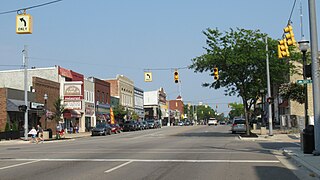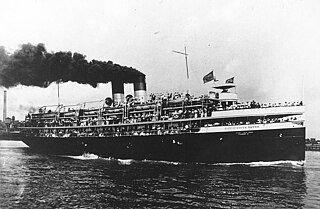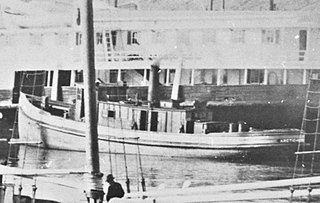
Lake Michigan is one of the five Great Lakes of North America. It is the second-largest of the Great Lakes by volume and the third-largest by surface area, after Lake Superior and Lake Huron. To the east, its basin is conjoined with that of Lake Huron through the 3+1⁄2-mile (5.6-kilometer) wide, 295-foot deep Straits of Mackinac, giving it the same surface elevation as its easterly counterpart; the two are geologically a single lake.

Ludington is a city in the U.S. state of Michigan. It is the county seat and the largest city in Mason County. The population was 7,655 at the 2020 census.

The Grand Trunk Milwaukee Car Ferry Company was the Grand Trunk Western Railroad's subsidiary company operating its Lake Michigan railroad car ferry operations between Muskegon, Michigan, and Milwaukee, Wisconsin, from 1905 to 1978. Major railroad companies in Michigan used rail ferry vessels to transport rail cars across Lake Michigan from Michigan's western shore to eastern Wisconsin to avoid rail traffic congestion in Chicago.

SS Badger is a passenger and vehicle ferry in the United States that has been in service on Lake Michigan since 1953. Currently, the ship shuttles between Ludington, Michigan, and Manitowoc, Wisconsin, a distance of 62 miles (100 km), connecting U.S. Highway 10 (US 10) between those two cities. She is the last coal-fired passenger vessel operating on the Great Lakes, and was designated a National Historic Landmark on January 20, 2016.

SS Milwaukee Clipper, also known as SS Clipper, and formerly as SS Juniata, is a retired passenger ship and automobile ferry that sailed under two configurations and traveled on all of the Great Lakes except Lake Ontario. The vessel is now docked in Muskegon, Michigan.
The Burger Boat Company, of Manitowoc, Wisconsin, United States, is a builder of custom-designed, hand-built pleasure cruisers. The company also produces commercial vessels and has produced military vessels in the past. It is the second oldest pleasure cruiser producer in the United States after Hodgdon, and the fifth oldest in the world.

The SS Christopher Columbus was an American excursion liner on the Great Lakes, in service between 1893 and 1933. She was the only whaleback ship ever built for passenger service. The ship was designed by Alexander McDougall, the developer and promoter of the whaleback design.
The Flint and Pere Marquette Railroad (F&PM) is a defunct railroad which operated in the U.S. state of Michigan between 1857 and 1899. It was one of the three companies which merged to become the Pere Marquette Railway.

The history of commercial passenger shipping on the Great Lakes is long but uneven. It reached its zenith between the mid-19th century and the 1950s. As early as 1844, palace steamers carried passengers and cargo around the Great Lakes. By 1900, fleets of relatively luxurious passenger steamers plied the waters of the lower lakes, especially the major industrial centres of Chicago, Milwaukee, Detroit, Cleveland, Buffalo, and Toronto.

USS City of South Haven (ID-2527) was a transport ship for the United States Navy at the close of World War I. Before the war, she was a passenger steamship that sailed as SS City of South Haven on the Great Lakes. In post-war civilian service she operated as SS City of Miami between Florida and Cuba before returning to the Great Lakes as SS E.G. Crosby. She was scrapped in 1942 following a fire.

The Escanaba & Lake Superior Railroad is a Class III shortline railroad that operates 347 miles (558 km) of track in Northeastern Wisconsin and the Upper Peninsula of Michigan. Its main line runs 208 miles (335 km) from Rockland, Michigan, to Green Bay, Wisconsin, and it also owns various branch lines and out-of-service track. In 1897, the Escanaba River Company built a seven-mile (11 km) railroad from Wells, Michigan, to tap a large hardwood timber stand at LaFave’s Hill. In 1898, the company name was changed to the Escanaba & Lake Superior Railway (E&LS).
The American Ship Building Company was the dominant shipbuilder on the Great Lakes before the Second World War. It started as Cleveland Shipbuilding in Cleveland, Ohio in 1888 and opened the yard in Lorain, Ohio in 1898. It changed its name to the American Ship Building Company in 1900, when it acquired Superior Shipbuilding, in Superior, Wisconsin; Toledo Shipbuilding, in Toledo, Ohio; and West Bay Shipbuilding, in West Bay City, Michigan. With the coming of World War I, the company also acquired Buffalo Dry Dock, in Buffalo, New York; Chicago Shipbuilding, in Chicago, Illinois; and Detroit Shipbuilding, in Wyandotte, Michigan. American Shipbuilding ranked 81st among United States corporations in the value of World War II military production contracts.
The Mason and Oceana Railroad (M&O) was a short common carrier, 3 ft narrow gauge logging railroad in the U.S. state of Michigan. Organized in 1887 and in operation from 1887 until 1909, it served the counties of Mason and Oceana in the northwestern quarter of Michigan's Lower Peninsula in the late 19th and early 20th centuries.

Due to its unique geography, being made of two peninsulas surrounded by the Great Lakes, Michigan has depended on many ferries for connections to transport people, vehicles and trade. The most famous modern ferries are those which carry people and goods across the Straits of Mackinac to the car-free Mackinac Island but before the Mackinac Bridge was built, large numbers of ferries carried people and cars between the two peninsulas. Other ferries continue to provide transportation to small islands and across the Detroit River to Canada. Ferries once provided transport to island parks for city dwellers. The state's only national park, Isle Royale cannot be reached by road and is normally accessed by ferry. The largest ferries in Michigan are the car ferries which cross Lake Michigan to Wisconsin. One of these, the SS Badger is one of the last remaining coal steamers on the Great Lakes and serves as a section of US Highway 10 (US 10). The Badger is also the largest ferry in Michigan, capable of carrying 600 passengers and 180 autos.

The SS Pere Marquette was the world's first steel train ferry. It sailed on Lake Michigan and provided a service between the ports of Ludington, Michigan, and Manitowoc, Wisconsin, for the Pere Marquette Railway from 1897 to 1930. The railway used the name Pere Marquette for many of its ships and ferries, adding a number to the end of the name.

The Arctic was a wooden hulled tugboat that worked on the Great Lakes of North America from 1881 to 1930. In 1930 the Arctic was stripped of her machinery, and abandoned at Manitowoc, Wisconsin. On June 22, 2018, the remains of the Arctic were listed on the National Register of Historic Places.
The City of Muskegon was a steel-hulled sidewheel package and passenger steamer, built in 1881 for service on the Great Lakes, which was wrecked early on Tuesday 28 October 1919 when it struck a pier at Muskegon, Michigan, at 0430 hrs., in a 60 mph gale, sinking in a period estimated between four and ten minutes. Nine crew and six passengers were killed. There are conflicting sources on the number on board, however. One account listed 37 passengers and a crew of 35.

The SS Alpena is a lake freighter. She was built in 1942 by the Great Lakes Engineering Works in Ecorse, Michigan, to carry iron ore. She was originally owned by the Pittsburgh Steamship Company, a subsidiary of United States Steel. After also hauling grain in addition to ore in the 1960s and 1970s, the ship was put into storage in 1982.













